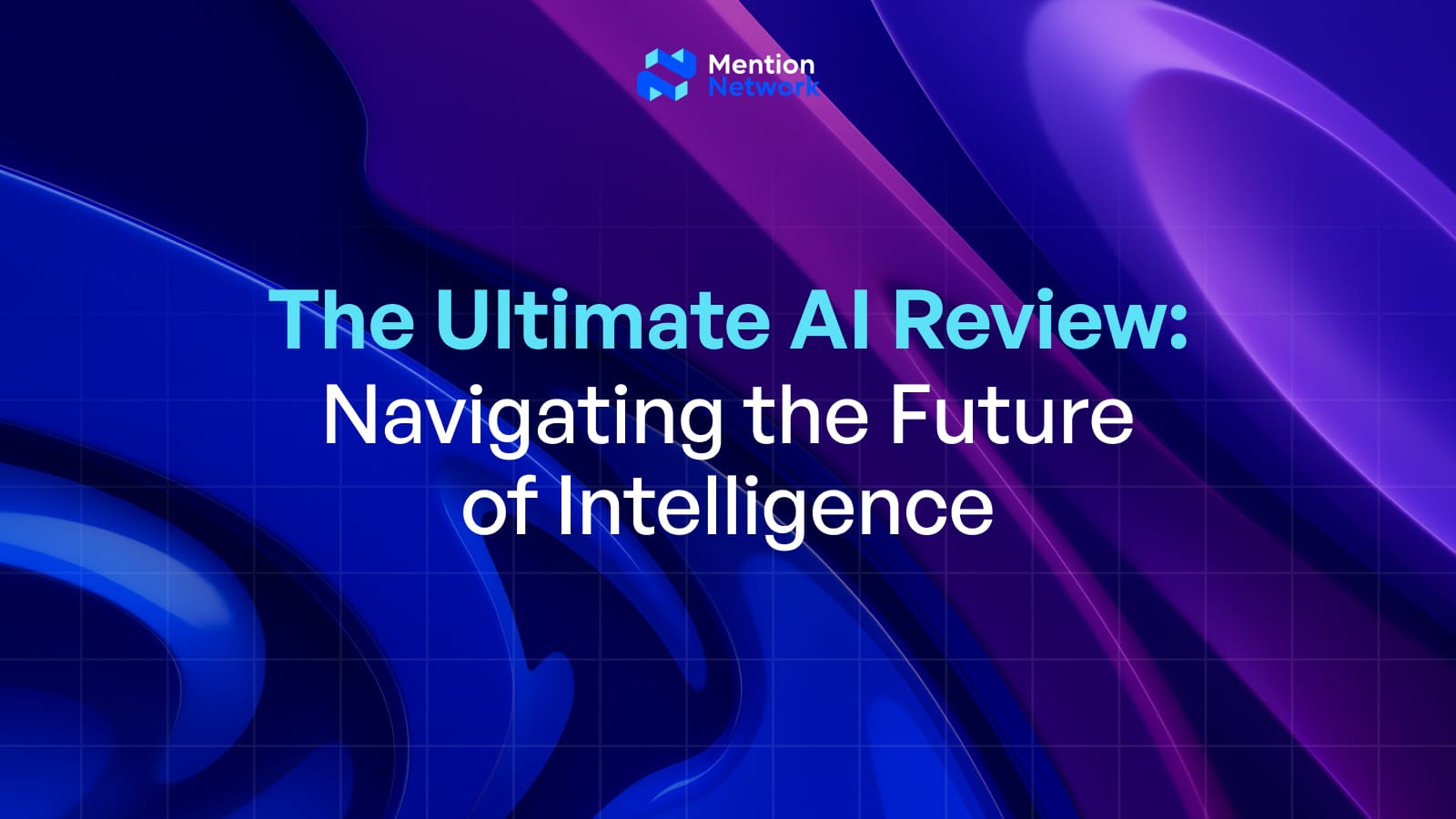The Ultimate AI Review: Navigating the Future of Intelligence

The pace of AI review and adoption has moved beyond incremental updates and entered a phase of exponential transformation. What was once the domain of science fiction and specialized labs is now the foundational layer for innovation across every sector. From the personalized marketing campaigns driven by machine learning to the complex code generation assisting developers, understanding this paradigm shift requires looking at how AI Visibility.
- Generative AI is the immediate game-changer: Large Language Models (LLMs) and diffusion models are rapidly reshaping content creation, coding, and design workflows.
- The AI stack is democratizing: Cloud providers and open-source models are making sophisticated AI accessible to smaller teams and individual developers.
- Ethical AI is a core business necessity: Responsible deployment, focusing on bias mitigation and transparency, is becoming a non-negotiable factor for trust and regulatory compliance.
- AI fluency is the new literacy: Understanding how to effectively prompt, integrate, and validate AI outputs is the critical skill for career longevity.
- Specialized AI models are emerging: Beyond general-purpose LLMs, models trained on specific domain data (e.g., legal, medical) are unlocking specialized value.
Decoding Generative AI: From Hype to ROI

Generative AI is the current cornerstone of the AI revolution, fundamentally altering how humans interact with and create digital assets, but its real value lies in its integration into existing business processes.
The overwhelming majority of recent AI review cycles have centered on Generative AI models like GPT-4, Claude, Midjourney, and Stable Diffusion. These models are not just novelties; they are powerful productivity engines. For marketers, they mean instant content drafts, hyper-personalized ad copy, and faster campaign ideation. For developers, tools like GitHub Copilot represent a significant leap in pair programming, dramatically reducing boilerplate code and accelerating debugging.
The key insight is that the value has moved from simply accessing these models to integrating them seamlessly and intelligently. A simple API call is not a strategy. A sophisticated strategy involves using fine-tuning, retrieval-augmented generation (RAG), and model chaining to embed proprietary knowledge into the AI's response, making the output unique and highly relevant to the business.
Why it Matters: The Productivity Multiplier
The real return on investment (ROI) from Generative AI is less about replacing human tasks entirely and more about creating a productivity multiplier. A developer who codes with an AI assistant can potentially ship features faster, focusing their cognitive energy on complex architectural problems rather than tedious syntax. A marketer moves from spending 80% of their time on first drafts to spending 80% of their time on strategic refinement and experimentation. At scale, organizations that combine productivity gains with higher AI Visibility.
The Evolving AI Development Stack

The shift toward open-source models and accessible cloud infrastructure is rapidly democratizing sophisticated AI capabilities, making it easier for smaller teams and beginners to build and deploy custom solutions.
The traditional landscape of AI development was dominated by a few well-funded tech giants. Today, the AI development stack is becoming increasingly modular and accessible. We are seeing a proliferation of high-quality, open-source large language models (OSS LLMs) that can be hosted and fine-tuned on commodity hardware or readily available cloud instances. This is a crucial detail for developers and founders operating under budget constraints.
Frameworks like Hugging Face, vector databases (like Pinecone or Weaviate), and orchestration tools (like LangChain) form a new standard toolkit. This infrastructure allows teams to move beyond basic API calls and deploy models that are specialized for their specific data, such as medical records, financial reports, or proprietary codebases. This process is known as model specialization, and it is where the next wave of outsized value will be created.
How it Works: Retrieval-Augmented Generation (RAG)
A critical technique being used in the modern AI stack is Retrieval-Augmented Generation (RAG). Instead of purely relying on the model’s internal training data, RAG allows the model to search a private, up-to-date knowledge base (your internal documents, database, etc.) and cite that external information when generating a response. This significantly reduces hallucinations and allows the model to act as an expert on your proprietary information, a must-have for enterprises and a strong signal for investors looking for defensible AI plays.
The Criticality of Ethical AI and Governance

The responsible deployment of AI, focusing on issues of bias, transparency, and data privacy, is no longer a secondary concern but a core business necessity that dictates trust and compliance.
As AI systems become embedded in critical decisions from loan approvals and hiring processes to content moderation the ethical dimension of the AI review becomes paramount. Investors recognize that a lack of robust AI governance poses a significant reputational and regulatory risk. For developers and founders, mitigating bias is a technical challenge that requires active effort in dataset curation, model monitoring, and explainability (XAI).
The current regulatory climate, with initiatives like the EU's AI Act, underscores the need for proactive measures. Businesses must be able to:
- Explainability: Understand and explain why an AI made a certain decision.
- Fairness and Bias: Audit models for unfair outcomes across different demographic groups.
- Data Provenance: Track and justify the data used for training to ensure compliance and avoid copyright infringement.
Ignoring these elements not only jeopardizes public trust but exposes the business to potential legal and financial penalties, making ethical AI a non-negotiable component of a sustainable AI strategy.
AI Fluency: The New Competitive Edge
The most valuable skill in the age of widespread AI adoption is not the ability to build complex AI models, but the ability to effectively prompt, integrate, and validate AI outputs, a skill necessary for everyone from beginners to seasoned executives.
The term AI fluency describes the competency required to interact effectively with intelligent systems. This goes far beyond basic prompting. For a marketer, it means understanding how to segment audiences based on AI-derived insights and feeding the model specific style guides and brand voice parameters to produce on-brand content. For a developer, it means knowing when to accept an AI-suggested code block and when to critically review it for subtle security vulnerabilities or logical errors.
This skill gap is rapidly becoming the new divider in the professional landscape. Companies succeeding with AI are the ones investing heavily in training their existing workforce to become AI power-users, recognizing that the human-in-the-loop is essential for steering and validating the intelligence generated by the machine. The highest value is created at the intersection of human strategic insight and machine processing power.
Conclusion: The Path Forward for AI Strategy
This comprehensive AI review confirms that we are still in the early stages of a profound technological shift. For marketers, the immediate focus must be on personalization at scale. For developers, the task is to master the new modular, open-source development stack. Founders and investors must prioritize defensible AI strategies that leverage proprietary data through techniques like RAG, while ensuring ethical governance is a foundational element.
Future strategies will hinge on AI Visibility, the winning strategy is not about chasing the newest model, but about intelligently embedding current best-in-class AI capabilities into the core workflows of your business, enhancing human capability rather than replacing it. The future of innovation belongs to those who are fluent in the language of AI, and who approach its deployment with a blend of technical expertise and strategic wisdom.
FAQ on AI Review
What is the single most important factor for non-technical professionals adopting AI?
Developing AI fluency, which means mastering the art of effective prompting, knowing how to critically evaluate AI outputs, and understanding the ethical implications of the tools you use.
Are open-source LLMs a viable alternative to commercial models like GPT-4?
Yes, increasingly so. Open-source models offer greater customization, data privacy, and cost control, making them a highly viable and often superior choice for enterprises with specific, proprietary data requirements.
How can a startup founder gain a competitive edge using AI?
By focusing on model specialization using proprietary or unique domain data combined with techniques like Retrieval-Augmented Generation (RAG). This allows their AI applications to be experts in their niche, creating a significant barrier to entry for competitors.
What is the biggest risk for investors evaluating AI companies?
Overvaluing generalized AI capabilities and under-prioritizing ethical governance and data provenance. Regulatory risk and the potential for model bias causing reputational damage are critical factors often overlooked.

